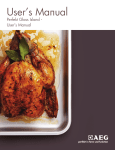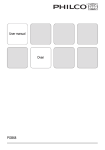Download AEG BC300001M 24 Oven User Manual
Transcript
User’s Manual BC300001M 24” Built-in Multi Function Oven User’s Manual 2 FOR PERFECT RESULTS Thank you for choosing this AEG product. We have created it to give you impeccable performance for many years, with innovative technologies that help make life simpler – features you might not find on ordinary appliances. Please spend a few minutes reading to get the very best from it. ACCESSORIES AND CONSUMABLES In the AEG webshop, you’ll find everything you need to keep all your AEG appliances looking spotless and working perfectly. Along with a wide range of accessories designed and built to the high quality standards you would expect, from specialist cookware to cutlery baskets, from bottle holders to delicate laundry bags… Visit the webshop at: www.aeg.com/shop Contents 3 CONTENTS 4 7 8 8 9 10 10 20 23 23 25 26 Safety information Product description Before first use Daily use Using the accessories Additional functions Helpful hints and tips Care and cleaning What to do if… Installation Environment concerns Guarantee/Customer Service Centres The following symbols are used in this user manual: Important information concerning your personal safety and information on how to avoid damaging the appliance. General information and tips Environmental information Subject to change without notice. 4 Safety information SAFETY INFORMATION Before the installation and use, read this manual carefully: • For your personal safety and the safety of your property • For the respect of the environment • For the correct operation of the appliance. Always keep these instructions with the appliance also if you move or sell it. The manufacturer is not responsible if incorrect installation or use results in damage. Children and vulnerable people safety • This appliance can be used by children aged from 8 years and above and persons with reduced physical, sensory or mental capabilities or lack of experience and knowledge if they have been given supervision or instruction concerning use of the appliance in safe way and understand the hazards involved. Children shall not play with the appliance. • Keep all packaging away from children. There is the risk of suffocation or physical injury. • WARNING: Keep children and animals away from the appliance when the door is open or the appliance is in the operation, because it becomes hot. There is the risk of injury or other permanent disability. • If the appliance has Child Lock or Key Lock (Control Lock) function, use it. It prevents children and animals from accidental operation of the appliance. General safety • Do not change the specifications of this appliance. There is the risk of injury and damage to the appliance. • Do not let the appliance stay unattended during operation. • Switch off the appliance after each use. Installation • Only an approved electrician can install and connect the appliance. Contact an approved service centre. This is to prevent the risks of structural damage or physical injury. • Make sure that the appliance is not damaged because of transport. Do not connect a damaged appliance. If necessary, contact the supplier. • Remove all packaging, stickers and layers from the appliance before first use. Do not remove the rating plate. It can invalidate the guarantee. • Make sure that the appliance is disconnected from the power supply during the installation. • Be careful when you move the appliance. The appliance is heavy. Always use safety gloves. Do not lift the appliance by the handle. • The electrical installation must have an isolation device which lets you disconnect the appliance from the mains at all poles. The isolation device must have a contact opening width of minimum 3 mm. • You must have correct isolation devices: line protecting cut-outs, fuses (screw type fuses removed from the holder), earth leakage trips and contactors. Safety information 5 • Before the installation, make sure that the kitchen cabinet has the recess dimensions applicable. • Make sure that the appliance is installed below and adjacent safe structures. • Keep the minimum distances to the other appliances and units. • The appliance cannot be positioned on a base. • Built in ovens and built in cooking surfaces are attached with special connection system. To prevent damage to the appliance, only use an appliance with the appliances from the same manufacturer. Electrical connection • The appliance must be earthed. • Make sure that the electrical data on the rating plate agree with your domestic power supply. • Information on the voltage is on the rating plate. • Always use a correctly installed shockproof socket. • Do not use multi-way plugs, connectors and extension cables. There is the risk of fire. • Do not replace or change the mains cable. Contact the service centre. • Make sure not to squash or cause damage to the mains plug (if applicable) and cable behind the appliance. • Do not pull the mains cable to disconnect the appliance. Always pull the mains plug – if applicable. Use • The appliance is only for domestic use. Do not use the appliance for commercial and industrial use. • Only use the appliance for domestic cooking tasks. This is to prevent physical injury to persons or prevent damage to property. • Do not use the appliance as a work surface or storage surface. • The interior of the appliance becomes hot during use. There is the risk of burns. Do not touch the heating elements in the appliance. Use gloves when you insert or remove the accessories or pots. • Be careful when you remove or install the accessories to prevent damage to the oven enamel. • Always stay away from the appliance when you open the door while the appliance is in operation. Hot steam can release. There is the risk of skin burns. • To prevent damage or discoloration to the enamel: – Do not put any objects directly on the appliance floor and do not cover it with aluminium foil. – Do not put water directly into the hot appliance. – Do not keep moist dishes and food in the appliance after you finish the cooking. • Discoloration of the enamel has no effect on the performance of the appliance so it is not a defect in the sense of the warranty law. • Do not apply pressure on the open door. 6 Safety information • Always close the appliance door when you cook, even while grilling. Care and cleaning • Before maintenance, switch off the appliance and disconnect the appliance from the power supply. • Before maintenance, make sure that the appliance is cold. There is the risk of burns. There is the risk that the glass panels can break. • Keep the appliance clean at all times. A build-up of fats or other foodstuff can result in a fire. • Regular cleaning prevents the surface material from deteriorating • Use a deep baking tray for very moist cakes to prevent that fruit juices cause stains that can be permanent. • For your personal safety and the safety of your property, only clean the appliance with water and a soap. Do not use flammable products or products that can cause corrosion. • Do not clean the appliance with steam cleaners, high-pressure cleaners, sharp objects, abrasive cleaning agents, abrasive sponges and stain removers • If you use an oven spray, follow the instructions from the manufacturer. • Do not clean the glass door with abrasive cleaning agents or metal scraper. Heat resistant surface of the inner glass can break and shatter. • When the door glass panels are damaged they become weak and can break. You must replace them. Contact the service centre. • Be careful when you remove the door from the appliance. The door is heavy! • Do not clean catalytic enamel (if applicable). Risk of fire • Open the door carefully. The use of ingredients with alcohol can cause a mixture of alcohol and air. There is the risk of fire. • Do not let sparks or open flames come near the appliance when you open the door. • Do not put flammable products or items that are wet with flammable products, and/or fusible objects (made of plastic or aluminium) in, near or on the appliance. Oven lamp • The type of light bulb or halogen lamp used for this appliance is only for household appliances. Do not use it for house lighting. • If it becomes necessary to replace the lamp, use one of the same power and specifically designed for household appliances only. • Disconnect the appliance from the power supply before the replacement of the oven lamp. There is the risk of electrical shock. Service centre • Only an approved engineer can repair or work on the appliance. Contact an approved service centre. • Use only original spare parts. Product description 7 Disposal of the appliance • To prevent the risk of physical injury or damage – Disconnect the appliance from the power supply. – Cut off the mains cable and discard it. – Discard the door catch. This prevents children or small animals from being closed inside of the appliance. There is the risk of suffocation. PRODUCT DESCRIPTION 2 3 4 5 1 6 7 5 4 12 3 8 2 1 9 10 11 1 2 3 4 5 6 7 8 9 10 11 Control panel Control knob for oven functions Power lamp/symbol Control knob for temperature Temperature lamp/symbol/indicator Heating element Oven lamp Fan Rear wall heating element Bottom heat Shelf support, removable 8 Before first use 12 Shelf positions Accessories • Wire shelf For cookware, cake tins, roasts. • Combi pan For cake and biscuits. To bake and roast or as pan to collect fat. BEFORE FIRST USE WARNING! Refer to "Safety information" chapter. Initial Cleaning • Remove all parts from the appliance. • Clean the appliance before first use. Refer to chapter "Care and Cleaning". DAILY USE WARNING! Refer to "Safety information" chapter. To use the appliance, press the control knob. The control knob comes out. Activating and deactivating the appliance 1. 2. Turn the control knob for the oven functions to select an oven function. Turn the control knob for the temperature to select a temperature. Using the accessories 3. 9 To deactivate the appliance turn the control knobs for the oven functions and temperature to off position. Knob symbol, indicator or lamp (depends on the model - refer to the appliance overview): • The indicator comes on when the oven heats up. • The lamp comes on when the appliance operates. • The symbol shows whether the knob controls one of the cooking zones, the oven functions or the temperature. Oven Functions Oven function Light Application Use this function to light up the oven interior. True Fan Cooking To bake maximum on three oven levels at the same time. Decrease the oven temperatures (70 - 100 °F) compared with Conventional. And to dry food. Pizza Setting To bake on one oven level food with a more intensive browning and a crispy base. Decrease the oven temperatures (70 - 100 °F) compared with Conventional Conventional Cooking Bottom Heat To bake and roast on one oven level. To bake cakes with crispy or crusty bases and to preserve food Defrost To defrost frozen food. Grilling To grill flat food in the middle of the grill and to toast. Fast Grilling Turbo Grilling To grill flat food in large quantities and to toast. To roast larger joints of meat or poultry on one level. Also for browning food e.g. gratin. USING THE ACCESSORIES WARNING! Refer to "Safety information" chapter. 10 Additional functions Installing the Oven Accessories The deep pan and the wire shelf have side edges. These edges and the shape of the guide-bars causes the anti-tilt safety for the oven accessories. Installing the wire shelf and the deep pan together Put the wire shelf on the deep pan. Push the deep pan between the guide-bars of one of the oven levels. ADDITIONAL FUNCTIONS Cooling fan When the appliance operates, the cooling fan activates automatically to keep the surfaces of the appliance cool. If you deactivate the appliance, the cooling fan can continue to operate until the appliance cools down. HELPFUL HINTS AND TIPS Inner side of door In some models on the inner side of the door you can find: • the numbers of the shelf positions (selected models) • information about the heating functions, recommended shelf positions and temperatures for typical dishes (selected models). The temperature and baking times in the tables are guidelines only. They depend on the recipes, quality and quantity of the ingredients used. Helpful hints and tips 11 Baking General instructions • Your new oven may bake or roast differently to the appliance you had before. Adapt your usual settings (temperature, cooking times) and shelf positions to the values in the tables. • With longer baking times, the oven can be switched off about 10 minutes before the end of baking time, to use the residual heat. When you use frozen food, the trays in the oven can twist during baking. When the trays get cold again, the distortion will be gone. How to use the Baking Tables • We recommend to use the lower temperature the first time. • If you cannot find the settings for a special recipe, look for the one that is almost the same. • Baking time can be extended by 10-15 minutes, if you bake cakes on more than one level. • Cakes and pastries at different heights do not always brown equally at first. If this occurs, do not change the temperature setting. The differences equalize during the baking procedure. Baking on one level: Baking in tins Type of baking Oven function Shelf position Temperature °F Time in min. Ring cake or brioche True Fan Cooking 1 300 - 320 50 - 70 Madeira cake/ fruit cakes True Fan Cooking 1 280 - 320 70 - 90 Sponge cake True Fan Cooking 2 280 - 300 35 - 50 Sponge cake Conventional Cooking 2 320 35 - 50 Flan base - short pastry True Fan Cooking 2 340 - 360 1) 10 - 25 Flan base sponge mixture True Fan Cooking 2 300 - 340 20 - 25 Apple pie (2tins Ø20cm, diagonally off set) True Fan Cooking 2 320 60 - 90 Apple pie (2tins Ø20cm, diagonally off set) Conventional Cooking 1 360 70 - 90 Cheesecake Conventional Cooking 1 340 - 380 60 - 90 1) Pre-heat the oven 12 Helpful hints and tips Cakes/pastries/breads on baking trays Type of baking Oven function Shelf position Temperature °F Time in min. Plaited bread/ bread crown Conventional Cooking 3 340 - 380 30 - 40 Christmas stollen Conventional Cooking 2 320 - 360 1) 50 - 70 Bread (rye bread): 1. First part of baking process. 2. Second part of baking process. Conventional Cooking 1 Cream puffs/ eclairs Conventional Cooking 3 380 - 410 1) 20 - 35 Swiss roll Conventional Cooking 3 360 - 4001) 10 - 20 Cake with crumble topping (dry) True Fan Cooking 3 300 - 320 20 - 40 Buttered almond cake/sugar cakes Conventional Cooking 3 380 - 410 1) 20 - 30 Fruit flans (made with yeast dough/ sponge mixture) True Fan Cooking 3 300 35 - 55 Fruit flans (made with yeast dough/ sponge mixture) Conventional Cooking 3 340 35 - 55 Fruit flans made with short pastry True Fan Cooking 3 320 - 340 40 - 80 Yeast cakes with delicate toppings (e. g, quark, cream, custard) Conventional Cooking 3 320 - 360 1) 40 - 80 Type of baking Oven function Shelf position Temperature °F Time in min. Short pastry biscuits True Fan Cooking 3 300 - 320 10 - 20 1. 2. 4501) 320 - 360 1. 2. 20 30 - 60 2) 2) 1) Pre-heat the oven 2) Use deep pan Biscuits Helpful hints and tips 13 Type of baking Oven function Shelf position Temperature °F Time in min. Short bread/ Pastry Stripes True Fan Cooking 3 280 20 - 35 Short bread/ Pastry Stripes Conventional Cooking 3 320 1) 20 - 30 Biscuits made with sponge mixture True Fan Cooking 3 300 - 320 15 - 20 Pastries made with egg white, merungues True Fan Cooking 3 180 - 210 120 - 150 Macaroons True Fan Cooking 3 210 - 250 30 - 50 Biscuits made with yeast dough True Fan Cooking 3 300 - 320 20 - 40 Puff pastries True Fan Cooking 3 340 - 3601) 20 - 30 10 - 25 Rolls True Fan Cooking 3 3201) Rolls Conventional Cooking 3 380 - 4101) 10 - 25 Small cakes (20per tray) True Fan Cooking 3 3001) 20 - 35 Small cakes (20per tray) Conventional Cooking 3 3401) 20 - 30 Temperature in °F Time in min. 1) Pre-heat the oven Multileveled Baking Cakes/pastries/breads on baking trays True Fan Cooking Type of baking Shelf position 2 levels 3 levels Cream puffs/ Eclairs 1/4 - 320 - 360 1) 25 - 45 Dry streusel cake 1/4 - 300 - 320 30 - 45 Temperature in °F Time in min. 300 - 320 20 - 40 1) Pre-heat the oven Biscuits/small cakes/pastries/rolls True Fan Cooking Type of baking Short pastry biscuits Shelf position 2 levels 3 levels 1/4 1/3/5 14 Helpful hints and tips True Fan Cooking Type of baking Shelf position Temperature in °F Time in min. 2 levels 3 levels Short bread/ Pastry Stripes 1/4 1/3/5 280 25 - 50 Biscuits made with sponge mixture 1/4 - 320 - 340 25 - 40 Biscuits made with egg white, meringues 1/4 - 180 - 210 130 - 170 Macaroons 1/4 - 210 - 250 40 - 80 Biscuits made with yeast dough 1/4 - 320 - 340 30 - 60 Puff pastries 1/4 - 340 - 360 1) 30 - 50 Rolls 1/4 - 360 30 - 55 Small cakes (20per tray) 1/4 - 3001) 25 - 40 1) Pre-heat the oven Tips on baking Baking results Possible cause Remedy Wrong shelf position. Place the cake lower. The oven temperature is too high. The next time you bake set a slightly lower oven temperature. The cake sinks (becomes soggy, lumpy, streaky). The baking time is too short. Set a longer baking time. Baking times cannot be reduced by setting higher temperatures. The cake sinks (becomes soggy, lumpy, streaky). There is too much liquid in the mixture. Use less liquid. Pay attention to mixing times, especially if you use a mixing machine. The cake is too dry. The oven temperature is too low. The next time you bake set a higher oven temperature. The cake is too dry. The baking time is too long. The next time you bake set a shorter baking time. The oven temperature is too high and the baking time is too short. Set a lower oven temperature and a longer baking time. The cake is not browned enough underneath. The cake sinks (becomes soggy, lumpy, streaky). The cake browns unevenly. Helpful hints and tips Baking results 15 Possible cause Remedy The cake browns unevenly. The mixture is unevenly distributed. Spread the mixture evenly on the baking tray. The cake is not ready in the baking time given. The oven temperature is too low. The next time you bake set a slightly higher oven temperature. Bakes and gratins Dish Oven function Shelf position Temperature °F Time in min. Pasta bake Conventional Cooking 1 360 - 400 45 - 60 Lasagne Conventional Cooking 1 360 - 400 25 - 40 Vegetables au gratin 1) Turbo Grilling or True Fan Cooking 1 320 - 340 15 - 30 Baguettes topped with melted cheese Turbo Grilling or True Fan Cooking 1 320 - 340 15 - 30 Sweet bakes Conventional Cooking 1 360 - 400 40 - 60 Fish bakes Conventional Cooking 1 360 - 400 30 - 60 Turbo Grilling or True Fan Cooking 1 320 - 340 30 - 60 Stuffed vegetables 1) Pre-heat the oven Roasting Roasting dishes • Use heat-resistant ovenware to roast (please read the instructions of the manufacturer). • Large roasting joints can be roasted directly in the deep pan (if present) or on the wire shelf above the deep pan. • Roast lean meats in a roasting tin with a lid. This will keep the meat more succulent. • All types of meat, that can be browned or have crackling, can be roasted in the roasting tin without the lid. Roasting with Turbo Grilling Beef Type of meat Pot roast Roast beef or fillet: rare Quantity Oven function Shelf position Temperature °F Time min. 1-1.5 kg Conventional Cooking 1 450 120 - 150 per cm. of thickness Turbo Grilling 1 380 - 4001) 5-6 16 Helpful hints and tips Type of meat Quantity Oven function Shelf position Temperature °F Time min. Roast beef or fillet: medium per cm. of thickness Turbo Grilling 1 360 - 380 1) 6-8 Roast beef or fillet: well done per cm. of thickness Turbo Grilling 1 340 - 3601) 8 - 10 Type of meat Quantity Oven function Shelf position Temperature °F Time min. Shoulder, neck, ham joint 1-1.5 kg Turbo Grilling 1 320 - 360 90 - 120 1) Pre-heat the oven Pork Chop, spare rib 1-1.5 kg Turbo Grilling 1 340 - 360 60 - 90 Meat loaf 750 g-1 kg Turbo Grilling 1 320 - 340 50 - 60 Porkknuckle (precooked) 750 g-1 kg Turbo Grilling 1 300 - 340 90 - 120 Veal Type of meat Quantity Oven function Shelf position Temperature °F Time min. Roast veal 1 kg Turbo Grilling 1 320 - 360 90 - 120 Knuckle of veal 1.5-2 kg Turbo Grilling 1 320 - 360 120 - 150 Type of meat Quantity Oven function Shelf position Temperature °F Time min. Leg of lamb, roast lamb 1-1.5 kg Turbo Grilling 1 300 - 340 100 - 120 Saddle of lamb 1-1.5 kg Turbo Grilling 1 320 - 360 40 - 60 Type of meat Quantity Oven function Shelf position Temperature °F Time min. Saddle of hare, leg of hare up to 1 kg Conventional Cooking 1 450 1) 30 - 40 Saddle of venison 1.5-2 kg Conventional Cooking 1 410 - 430 35 - 40 Haunch of venison 1.5-2 kg Conventional Cooking 1 360 - 400 60 - 90 Lamb Game 1) Pre-heat the oven Helpful hints and tips 17 Poultry Type of meat Quantity Oven function Shelf position Temperature °F Time min. Poultry portions 200-250g each Turbo Grilling 1 400 - 430 30 - 50 Half chicken 400-500g each Turbo Grilling 1 380 - 410 35 - 50 Chicken, poulard 1-1.5 kg Turbo Grilling 1 380 - 410 50 - 70 Duck 1.5-2 kg Turbo Grilling 1 360 - 400 80 - 100 Goose 3.5-5 kg Turbo Grilling 1 320 - 360 120 - 180 Turkey 2.5-3.5 kg Turbo Grilling 1 320 - 360 120 - 150 Turkey 4-6 kg Turbo Grilling 1 280 - 320 150 - 240 Type of meat Quantity Oven function Shelf position Temperature °F Time min. Whole fish 1-1.5 kg Conventional Cooking 1 410 - 430 40 - 60 Fish (steamed) Grilling Always grill with the maximum temperature setting. CAUTION! Always grill with the oven door closed. Always pre-heat the empty oven with the grill functions for 5 minutes. • Set the shelf in the shelf position as recommended in the grilling table. • Always set the pan to collect the fat into the first shelf position. • Grill only flat pieces of meat or fish. Grilling Food to be grilled Shelf position Temperature °F Time in min. 1st side 2nd side 410 - 450 30 - 40 30 - 40 Roast beef 2 Filet of beef 3 450 20 - 30 20 - 30 Back of pork 2 410 - 450 30 - 40 30 - 40 Back of veal 2 410 - 450 30 - 40 30 - 40 Back of lamb 3 410 - 450 25 - 35 20 - 25 Whole Fish, 500-1000g 3/4 410 - 450 15 - 30 15 - 30 18 Helpful hints and tips Fast Grilling Food to be grilled Shelf position Time in min. 1st side 2nd side Burgers 4 8 - 10 6-8 Pork fillet 4 10 - 12 6 - 10 Sausages 4 10 - 12 6-8 Fillet steaks, veal steaks 4 7 - 10 6-8 Toast 1) 5 1-3 1-3 Toast with topping 4 6-8 - Shelf position Temperature °F Time Min. Pizza (thin crust) 2 400 - 450 1)2) 15 - 20 Pizza (with a lot of topping) 2 360 - 400 20 - 30 Tarts 1 360 - 400 40 - 55 Spinach flan 1 320 - 360 45 - 60 Quiche Lorraine 1 340 - 380 45 - 55 Swiss Flan 1 340 - 380 45 - 55 Apple cake, covered 1 300 - 340 50 - 60 Vegetable pie 1 320 - 360 50 - 60 Unleavened bread 2 450 - 4801) 10 - 20 Puff pastry flan 2 320 - 360 1) 45 - 55 Flammekuchen (Pizzalike dish from Alsace) 2 450 - 4801) 12 - 20 Piroggen (Russian version of calzone) 2 360 - 400 1) 15 - 25 1) Pre-heat the oven Pizza Setting Type of baking 1) Pre-heat the oven 2) Use deep pan Defrosting Remove the food packaging. Put the food on a plate. Do not cover it with a bowl or a plate. This can extend the defrost time. Use the first oven shelf position. The one on the bottom. Helpful hints and tips Dish Defrosting time in min. Further defrosting time in min. 19 Comment Chicken, 1000 g 100 - 140 20 - 30 Place the chicken on an upturned saucer placed on a large plate Turn halfway through Meat, 1000 g 100 - 140 20 - 30 Turn halfway through Meat, 500 g 90 - 120 20 - 30 Turn halfway through Trout, 150 g 25 - 35 10 - 15 - Strawberries, 300 g 30 - 40 10 - 20 - Butter, 250 g 30 - 40 10 - 15 - Cream, 2 x 200 g 80 - 100 10 - 15 Cream can also be whipped when still slightly frozen in places Gateau, 1400 g 60 60 - Drying - True Fan Cooking Cover the oven shelves with baking parchment. For best results: deactivate the appliance after half the time required. Open the appliance door and let the appliance cool down. After that finish the drying process. Vegetables Food to be dried Shelf position Temperature °F Time in hours 1/4 140 - 160 6-8 3 1/4 140 - 160 5-6 Vegetables for sour 3 1/4 140 - 160 5-6 Mushrooms 3 1/4 120 - 140 6-8 Herbs 3 1/4 100 - 120 2-3 Temperature °F Time in hours 1 level 2 levels Beans 3 Peppers Fruit Food to be dried Shelf position 1 level 2 levels Plums 3 1/4 140 - 160 8 - 10 Apricots 3 1/4 140 - 160 8 - 10 Apple slices 3 1/4 140 - 160 6-8 Pears 3 1/4 140 - 160 6-9 20 Care and cleaning Information on acrylamides Important! According to the newest scientific knowledge, if you brown food (specially the one which contains starch), acrylamides can pose a health risk. Thus, we recommend that you cook at the lowest temperatures and do not brown food too much. CARE AND CLEANING WARNING! Refer to "Safety information" chapter. Notes on cleaning: • Clean the front of the appliance with a soft cloth with warm water and cleaning agent. • To clean metal surfaces use a usual cleaning agent. • Clean the appliance interior after each use. Then you can remove dirt more easily and it does not burn on. • Clean stubborn dirt with a special oven cleaner. • Clean all accessories (with a soft cloth with warm water and cleaning agent) after each use and let them dry. • If you have nonstick accessories, do not clean them using an aggressive agents, sharp edged objects or dishwasher. It can cause a damage to the nonstick coating. Catalytic walls The walls with a catalytic coating are self-cleaning. They absorb fat which collects on walls while the oven operates. To support this self-cleaning process heat the oven without any food regularly: • Turn the oven light on. • Remove accessories from the oven. • Clean the oven floor with warm water and washing up liquid, then dry it. • Set the function. • Set the oven temperature to 480 °F and let oven operate for 1 hour. • Clean the oven cavity with a soft and damp sponge. WARNING! Do not attempt to clean catalytic surface with oven sprays, abrasive cleaners, soap or other cleaning agents. This will damage the catalytic surface. Discolouration of the catalytic surface has no effect on catalytic properties. Shelf support You can remove the shelf support to clean the side walls. Care and cleaning 21 Removing the shelf support 1. Pull the front of the shelf support away from the side wall. 2. Pull the shelf support from the back of the side wall to remove it. To install the shelf support follow the procedure in reverse. Valid with telescopic runners: The retaining pins on the telescopic shelf runners must point to the front! 2 1 Oven lamp WARNING! There is a risk of electrical shock. The oven lamp and the lamp glass cover can be hot. Before you change the oven lamp: • Deactivate the appliance. • Remove the fuses from the fuse box or deactivate the circuit breaker. CAUTION! Put a cloth on the bottom of the interior of the appliance. It prevents damage to the lamp glass cover and the cavity. Replacing the oven lamp: 1. You can find the lamp glass cover at the cavity ceiling. Turn the lamp glass cover counterclockwise to remove it. 2. Clean the glass cover. 3. If necessary, replace the oven lamp with applicable 570 °F heat-resistant oven lamp. Use the same oven lamp type. 4. Install the glass cover. 22 Care and cleaning Door and glass panels To clean the door, remove it. CAUTION! Be careful when you remove the door from the appliance. The door is heavy! Removing the door 1. Open the door as far as it goes. 2. Fully press clamping levers (A) on the two door hinges. 3. Close the door until the first position (angle approximately 70°). 4. Hold of the door with one hand on each side and pull it away from the at an up angle. A A To install the door follow the procedure in reverse. The number of glass panels if different for the different models. CAUTION! Put the door with the outer side down on a soft and level surface to prevent scratches. Removing and cleaning the door glass panels 1. Remove the door. 2. Hold the door trim (B) on the top edge of the door at the two sides and push inwards to release the clip seal. 3. Pull the door trim to the front to remove it. B 4. 5. Hold the door glass panels on their top edge one by one and pull them up out of the guide Clean the door glass panels. To install panels follow the procedure in reverse. Install the smaller panel first, then the larger. What to do if… 23 WHAT TO DO IF… WARNING! Refer to "Safety information" chapter. Problem Possible cause Remedy The oven does not heat up The oven is not switched on Switch on the oven (refer to chapter "Daily use"). The oven does not heat up The fuse in the fuse box is released Control the fuse. If the fuse is released more than one time, refer to a qualified electrician. The oven lamp does not operate The oven lamp is defective Replace the oven lamp Steam and condensation settle on the food and in the oven cavity You left the dish in the oven for too long Do not leave the dishes in the oven for longer than 15-20 minutes after the cooking process ends If you cannot find a solution to the problem yourself, contact your dealer or the service centre. The necessary data for the service centre is on the rating plate. The rating plate is on the front frame of the appliance cavity. We recommend that you write the data here: Model (MOD.) Product number (PNC) Serial number (S.N.) ......................................... ......................................... ......................................... INSTALLATION WARNING! Refer to "Safety information" chapter. The built-in unit must meet the stability requirements of DIN 68930. min. 3 mm 24 Installation 200 cm2 547 546 114 590 560 min. 20 572 530 min. 594 579 5 590 min. 567 594 21 30 max. R1200 mm 130 140 alternativ 100 H05VV-F H05RR-F min. 1600 mm Environment concerns 25 90º 2x3,5x25 ENVIRONMENT CONCERNS The symbol on the product or on its packaging indicates that this product may not be treated as household waste. Instead it should be taken to the appropriate collection point for the recycling of electrical and electronic equipment. By ensuring this product is disposed of correctly, you will help prevent potential negative consequences for the environment and human health, which could otherwise be caused by inappropriate waste handling of this product. For more detailed information about recycling of this product, please contact your local council, your household waste disposal service or the shop where you purchased the product. Packaging material The packaging material is environmentally-friendly and recyclable. Plastic parts are marked with international abbreviations such as PE, PS, etc. Dispose of the packaging material in the containers provided for this purpose at your local waste management facility. 26 Guarantee/Customer Service Centres GUARANTEE/CUSTOMER SERVICE CENTRES EURO-LINE APPLIANCES INC. LENGTH OF WARRANTY EURO-LINE WILL PAY FOR: TWO YEAR FULL WARRANTY from original date of purchase, including parts and labour, to the first purchaser of this appliance Replacement parts and/or labour to repair defects in materials or workmanship. Service must be provided by an authorized Euro-Line company (unless advised otherwise). THIS GUARANTEE DOES NOT COVER COMMERCIAL USE. The name Euro-Line Appliances, for service matters, incorporates work performed by authorized service agents or service companies. EXCEPTIONS: EURO-LINE APPLIANCES WILL NOT PAY FOR THE FOLLOWING SERVICE CALLS: 1. To install or correct the installation of an appliance 2. To instruct the use of an appliance. 3. To replace house fuses, re-set circuit breakers or correct house wiring. 4. To correct house plumbing. 5. To clean drains, filters or garbage disposers. 6. To repair an appliance if it fails due to misuse or abuse. EURO-LINE APPLIANCES WILL NOT PAY WHEN THE FOLLOWING OCCURS: 1. Damage resulting from fires, acts of God, alteration, improper installation, or installation not in accordance with local building codes. 2. Pickup or delivery of major appliances requiring service. The appliances are designed to be repaired in the home. However, Euro-Line will not be responsible for travelling and labour costs if the customer lives in excess of 50 km/30 miles, or if the travel time is in excess of 30 minutes from the nearest service center. Any excess to this will not be covered by the warranty. In no event, will Euro-Line be responsible for incidental or consequential damages. For warranty service and parts, contact EURO-PARTS. Service will be provided during normal business hours. Should you have a service problem that is not resolved locally, contact: For Service and Parts Contact: EURO-PARTS, USA EURO-PARTS, CANADA EURO-LINE APPLIANCES Tel: 1-800-561-4614 Fax: 1-519-528-5001 Tel: 1-800-678-8352 Fax: 1-519-528–5001 1-800-421-6332 Tel. Direct: 1-905-829-3980 Fax: 1-905-829-3985 User Instructions & Installation Manual Service & Repair To save you time and money please have the following information ready in case you have to call for service: • Name of the dealer from whom you purchased the appliance. • Model number (shown on the rating plate) • Serial number (shown on the rating plate) 27 • Date of purchase. You should also retain the original purchase receipt to support any claim made under the warranty. (We suggest you staple the receipt to this page). If service is required, contact the Service Center: EURO-PARTS, CANADA EURO-PARTS, USA Tel: 1–800–678–8352 Fax: 1-519-528-5001 Tel: 1-800-561-4614 Fax: 1-519-528-5001 DISTRIBUTED BY: EURO-LINE APPLIANCES INC. 2278 SPEERS ROAD OAKVILLE, ON, CANADA L6L 2X8 1-800-421-6332 Tel: 905-829-3980 Fax: 905-829-3985 www.euro-line-appliances.com Q- Warranty AEG products are designed and built to the highest standards. We expect your appliances to provide many years of trouble free enjoyment. In the event of an appliance requiring attention, each appliance is covered by a 2 year warranty from the date of purchase. Refer to warranty policy for complete terms and conditions. Coverage is for costs of parts and labor for appliances in capital cities & metropolitan areas. We reserve the right to charge directly for handling expenses outside the metropolitan region. AEG products are supported by a national service support system. Call our customer service department for attention. Please retain your invoice AEG to quote should you require service assistance. This will identify your product for our priority service back-up. Please attach your invoice to this manual for easy future reference. AEG Canada 871 Cranberry Court Oakville, Ontario L6L 6J7 Canada Tel 905-829.3980 Fax 905-829.3985 email [email protected] For Service & Spares: EURO-PARTS 1.800.678.8352 Important: Please record details of your purchase below and mail or fax to AEG -----------------------------------------------------------------------------------------cut along line ------------------------------------------------------------------------------------ Name: Address: City : Where purchased: Items Serial No. (s): TEL No State: Zip Code: Purchase date: purchased: 33 AEG appliances are imported and distributed in North America by Euro-Line Appliances Inc. For more information visit www.euro-line-appliances.com / www.elawest.com 871 Cranberry Court Oakville, ON L6L 6J7 Canada Toll Free: 1.800.421.6332 Showroom: 905.829.3980 [email protected] 2912 West 4th Ave Vancouver, BC V6K 1R2 Canada Toll Free: 1.855.352-9378 Showroom: 604.235.3980 [email protected]


















































